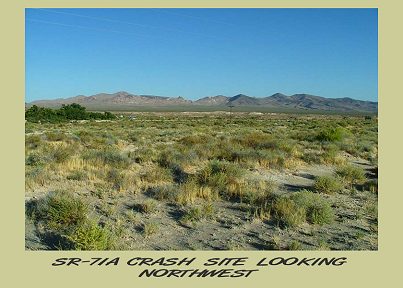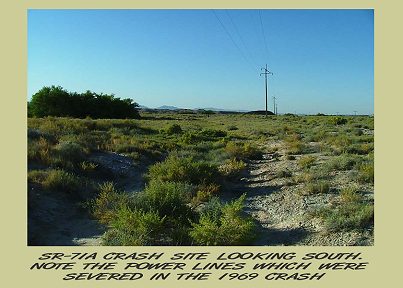We're on a Mission
Tony Moore and Pete Merlin decided to search for the crash site of 953 in the fall of 1992. At that time, all they knew was that the Blackbird had crashed near the town of Shoshone at the southern end of Death Valley. They wondered how they might narrow their search area.
Tony had a brainstorm. He called the Death Valley Chamber of Commerce and asked how he could contact the oldest living resident of Shoshone. After making a few calls, he found himself in contact with some people who remembered the incident. They recalled that the airplane had severed the Continental-Edison power transmission lines north of town. The communities of Shoshone, Tecopa, and Zabriskie were deprived of electricity and phone service. One resident gave a simple and accurate description of the crash location. Pete and Tony were ready to roll.
Because Shoshone was a five-hour drive from Los Angeles, they decided to get an early start and arrive at the crash site at sunrise on 12 December. Leaving around midnight, they drove though the predawn hours and made a brief stop for food and fuel in the town of Baker.
One hour before sunrise, they climbed into the car. Pete looked at Tony and paraphrased a line from The Blues Brothers. "We're 56 miles from Shoshone. We have a full tank of gas, half a cup of coffee, it's dark out, and we're wearing sunglasses." Tony recognized his cue and gave the proper response: "Hit it!"
An hour later, they parked at the location they had been given. The rim of the sun was just appearing over the eastern horizon. The ground was frosty. After walking a few steps, Pete picked up what appeared to be a piece of damp cardboard (it would later be identified as composite material from the Blackbird's chines. Tony found a small piece of titanium with evidence of fire damage. As they continued further into the debris field pieces became larger and more plentiful.
Pete and Tony had found the impact site of the aft fuselage, wings, and engine section. Debris included structural components, titanium and composite skin, and engine components. Many pieces were marked with part numbers and inspection stamps. The largest piece (a titanium skin panel from an engine nacelle, with blow-in doors) was marked with the Lockheed ship number 2004.
Next, they located the forward fuselage impact site. There they found numerous items from the cockpit and RSO station. One such item was a metal placard from the bottom of the triple display indicator (TDI). It was marked on the front with the words: [RAD]IO CALL 17953. On the back, it was stamped with the ship number: 2004.

© Copyright 2004-, The X-Hunters. All rights reserved. Copyright Policy Privacy Policy Page last modified 05/01/2023



